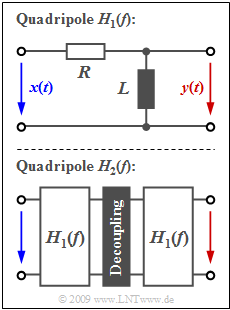Exercise 3.1: Causality Considerations
The graph shows above the two-port network with the transfer function
- $$H_1(f) = \frac{{\rm j}\cdot f/f_{\rm G}}{1+{\rm j}\cdot f/f_{\rm G}} \hspace{0.05cm},$$
where $f_{\rm G}$ represents the 3dB cut-off frequency:
- $$f_{\rm G} = \frac{R}{2 \pi \cdot L} \hspace{0.05cm}.$$
By cascading $n$ two-port networks $H_1(f)$ built the same way, the transfer function
- $$H_n(f) = \big [H_1(f)\big ]^n =\frac{\big [{\rm j}\cdot f/f_{\rm G}\big ]^n}{\big [1+{\rm j}\cdot f/f_{\rm G}\big ]^n} \hspace{0.05cm}$$ is obtained.
- Here, a suitable resistor decoupling is presumed, but this is not important for solving this exercise.
- The lower graph shows for example the realization of the transfer function $H_2(f)$.
In this exercise, such a two-port network is considered with respect to its causality properties.
For any causal system, the real and imaginary parts of the spectral function $H(f)$ satisfy the Hilbert transformation, which is expressed by the following abbreviation:
- $${\rm Im} \left\{ H(f) \right \} \quad \bullet\!\!-\!\!\!-\!\!\!-\!\!\hspace{-0.05cm}\rightarrow\quad {\rm Re} \left\{ H(f) \right \}\hspace{0.05cm}.$$
Since the Hilbert transformation provides important information not only for transfer functions but also for time signals, the correspondence is often expressed by the general variable $x$ , which is to be interpreted - depending on the application - as normalized frequency or normalized time.
Please note:
- The exercise belongs to the chapter Conclusions from the Allocation Theorem.
- Reference is also made to the theory pages Hilbert transformation and Partial fraction decomposition.
Questions
Solution
- Die angegebene Übertragungsfunktion kann man nach dem Spannungsteilerprinzip berechnen. Es gilt:
- $$H_1(f = 0) = 0, \hspace{0.2cm}H_1(f \rightarrow \infty) = 1$$
- Es handelt sich um einen Hochpass.
- Für sehr niedrige Frequenzen stellt die Induktivität $L$ einen Kurzschluss dar.
(2) Richtig ist Ja:
- Jedes reale Netzwerk ist kausal. Die Impulsantwort $h(t)$ ist gleich dem Ausgangssignal $y(t)$, wenn zum Zeitpunkt $t= 0$ am Eingang ein extrem kurzfristiger Impuls – ein so genannter Diracimpuls – angelegt wird.
- Aus Kausalitätsgründen kann dann natürlich am Ausgang nicht schon für Zeiten $t< 0$ ein Signal auftreten:
- $$y(t) = h(t) = 0 \hspace{0.2cm}{\rm{f\ddot{u}r}} \hspace{0.2cm} t<0 \hspace{0.05cm}.$$
- Formal lässt sich dies folgendermaßen zeigen: Die Hochpass–Übertragungsfunktion $H_1(f)$ kann wie folgt umgeformt werden:
- $$H_1(f) = \frac{{\rm j}\cdot f/f_{\rm G}}{1+{\rm j}\cdot f/f_{\rm G}} = 1- \frac{1}{1+{\rm j}\cdot f/f_{\rm G}} \hspace{0.05cm}.$$
- Die zweite Übertragungsfunktion beschreibt die zu $H_1(f)$ äquivalente Tiefpassfunktion, die im Zeitbereich zur Exponentialfunktion führt.
- Die "$1$" wird zu einer Diracfunktion. Mit $T = 2\pi \cdot f_{\rm G}$ gilt somit für $t \ge 0$:
- $$h_1(t) = \delta(t) - {1}/{T} \cdot {\rm e}^{-t/T} \hspace{0.05cm}.$$
- Für $t< 0$ gilt dagegen $h_1(t)= 0$, womit die Kausalität nachgewiesen wäre.
(3) Die Hintereinanderschaltung zweier Hochpässe führt zu folgender Übertragungsfunktion:
- $$H_2(f) = \big [H_1(f)\big ]^2 =\frac{\big [{\rm j}\cdot f/f_{\rm G}\big ]^2}{\big [1+{\rm j}\cdot f/f_{\rm G}\big ]^2} =\frac{\big [{\rm j}\cdot f/f_{\rm G}\big ]^2 \cdot \big [(1-{\rm j}\cdot f/f_{\rm G})\big ]^2} {\big [(1+{\rm j}\cdot f/f_{\rm G}) \cdot (1-{\rm j}\cdot f/f_{\rm G})\big ]^2}= \frac{(f/f_{\rm G})^4 - (f/f_{\rm G})^2 +{\rm j}\cdot 2 \cdot (f/f_{\rm G})^3)} {\big [1+(f/f_{\rm G})^2 \big ]^2}\hspace{0.05cm}.$$
- Mit $f = f_{\rm G}$ folgt daraus:
- $$H_2(f = f_{\rm G}) = \frac{1 - 1 +{\rm j}\cdot 2} {4}= {\rm j} /{2} \hspace{0.5cm}\Rightarrow \hspace{0.5cm}{\rm Re} \left\{ H_2(f = f_{\rm G}) \right \} \hspace{0.15cm}\underline{ = 0}, \hspace{0.4cm} {\rm Im} \left\{ H_2(f = f_{\rm G}) \right \} \hspace{0.15cm}\underline{ = 0.5}\hspace{0.05cm}.$$
(4) Richtig sind die beiden ersten Lösungsvorschläge:
- Da für $t < 0$ die Impulsantwort $h_1(t) = 0$ ist, erfüllt auch die Faltungsoperation $h_2(t) = h_1(t) \star h_1(t)$ die Kausalitätsbedingung. Ebenso ergibt die $n$–fache Faltung eine kausale Impulsantwort: $h_n(t) = 0 \hspace{0.2cm}{\rm{f\ddot{u}r}} \hspace{0.2cm} t<0 \hspace{0.05cm}.$
- Bei kausaler Impulsantwort $h_2(t)$ hängen aber der Real– und der Imaginärteil der Spektralfunktion $H_2(f)$ über die Hilbert–Transformation zusammen. Mit der Abkürzung $x = f/f_{\rm G}$ und dem Ergebnis der Teilaufgabe (3) gilt somit:
- $$\frac{x^4- x^2}{x^4+2 x^2+1} \quad \bullet\!\!-\!\!\!-\!\!\!-\!\!\hspace{-0.05cm}\rightarrow\quad \frac{2x^3}{x^4+2 x^2+1}\hspace{0.05cm}.$$
